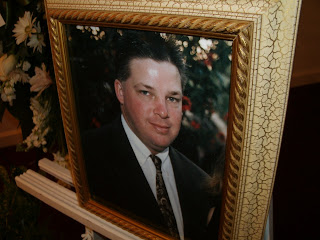We rolled into tiny Stanley, Nebraska for a bite to eat and a little local color. The only food they make at the Central Bar is deep fried so we ordered poppers and onion rings, a decision we would later regret. Mandy was curious about a menu item labeled as 'breaded boob'. The taciturn cook wearing a cowboy hat didn't look up. "Fried chicken breast," he replied quietly. We had finally left corn country and passed into the world of hay farming and cattle ranching.
"Most of the ranchers are gone or in nursing homes," the sweet (after we prodded her with questions) rotund bar maid told us. "The kids don't have no interest in ranching these days." She pointed up to rows of wooden plaques lining the support rafters. "These are the names and brands of ranchers that used to come in here. One by one, she announced the names on the plaques followed by "He's gone," or "he's in the home."
As we continued on US 20, we noticed a small road running along side 100 feet to the south. I decided to have a closer look. I turned into a connecting lane and took a photo of what I believe is the original route 20, now delegated to a jogging and bike path. Not surprisingly, we saw no joggers or bicyclists.
This is probably the road the my mother, father, Marc, and I travelled to visit Yellowstone back in the early 50s.
Hay farms have replaced corn as we travelled further north. When we arrived in Valentine, Nebraska we stopped to ask locals about places to camp and things to see. At a tavern, we met Maynard, a WWII vet and retired rancher who lived in northern Nebraska all of his life except for a stint in the Army.
"As a kid, I didn't know anyone lived a life different from me. I learned to ride a horse about the same time I learned to walk. I rode to school, to visit friends and family, to church, and everywhere else. I thought that everyone did that until I joined the Army." Maynard caught the tail end of the war and never left U.S. soil.
"When I spent two years in the Carolinas, I met black people for the first time. I loved those people. I have never had as much fun before or since." I smile grew on his face as he reminisced.
Mandy asked about mounting a horse. Did native Americans really teach their horses to let them mount on the right so that if someone tried to steal the horse, the animal would buck them off for mounting from the left.
"I lived on a reservation for two years and I never heard that," he said. "You always mount from the left. Although I once had a horse that wouldn't let anyone ride him except me. He wouldn't even let my father ride him."
Maynard told us about how he should have moved further south to farm corn. "They are all millionaires now down there. Once they perfected irrigation systems, they could grow corn faster than they could sell it. Up here, the sandy hills are too rolly to drag an irrigation system over it. But we have prairies up here where the cattle can graze. Further south they have to herd the cattle into feed lots to fatten them up."
Maynard's father, a rancher, did grow a few crops. "Sometimes the wind would blow near hurricane force and blow the sand out of a gully. We call that a 'blow out'. My father would go down into the blow out and drill a water well then plant crops. Contrary to what many think, the sand is full of nutrients and the crops grew well."
Maynard also told us about the rodeo cowboys. "If you get to be a really good horseman, you can make big money riding the rodeo. They make a lot of money then gamble it all away then go back to make more money in another rodeo then gamble it away."
"You ought to go try your luck at the Rosebud Casino just 11 miles up the road in South Dakota," he smiled. It was an ornery smile.
Mandy wanted to take Maynard's advice. Pictured here is the Rosebud Casino. She felt that her karma was going to give her good luck. She turned a $20 into quarters and chose her lucky one-armed-bandit. The trouble with gambling machines is that they don't care about karma. They are dogmatic random number generators. The machine's dogma collided with Mandy's karma devouring it like a pitbull tearing apart a Mini Cooper. Within an hour, her 20 bucks was dead and gone along the road-ma.
 These photos show some of the Badlands but none of them show the true scale and depth of the formations there.
These photos show some of the Badlands but none of them show the true scale and depth of the formations there.






































.jpg)